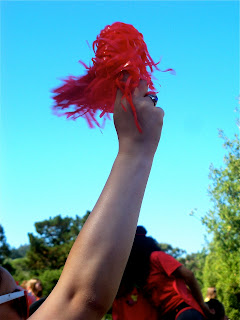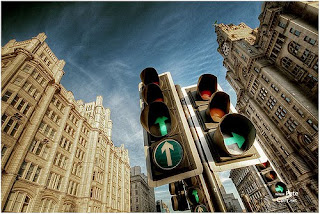Watching this film in class was both interesting and boring. When the film first started, I was confused on how this related to photography and didn't understand the point of it. As the movie went on, different slideshows of different places around the world began to interest me and I started to pay closer attention to what they were showing and all of the little details in the background. Some of the images shown with people in them were disturbing because of the facial expressions they showed or even what they were wearing, but I can't judge because that's their culture. I never really paid attention to other cultures besides my own so seeing all of the different images of different countries was kind of cool to see.
I enjoyed seeing all of the different landscapes and the colors in all of the images. The movie made somewhat of an impact on me because it made me realize what I had and what others in the third world countries didn't. I never researched or had an interest in seeing different peoples cultures, what they did on a daily basis, or what they had to go through. But after watching this film, it has caught my interest and made me realize that I need to appreciate and be thankful for what I have and I also need to realize that what I consider "terrible", isn't that bad.
Monday, November 29, 2010
Wednesday, November 17, 2010
Thursday, November 11, 2010
One Shot:
I took this picture in the Rose Garden at Mercy Burlingame. It was the only petal in the fountain and I thought it would be nice to emphasize the color.
Thursday, November 4, 2010
Photography Video:
-Kodak "Brownie" camera = $1.00
-Photos are visual records of peoples lives; capture way of life
-Before, people have pictures taken once or twice in their lifetime
-Postcards
--events, death, family, disasters, county fairs, political parties, etc
-Pictures were hand processed
-19th Century - no pictures in magazines or newspapers because of how long process was
-1905: National Geographic (Wentzel)
--Pictures informed impressions of the world; got to see what was happening in different parts of world.
--Went from 3,000 subscribers to over 1,000,000 in five years
-Edward Curtis: took pictures of what he believed would disappear
-People aregued whether photography was an art or not
-Straight Photography: no manipulating the photo; photo is what it is
-Photos are visual records of peoples lives; capture way of life
-Before, people have pictures taken once or twice in their lifetime
-Postcards
--events, death, family, disasters, county fairs, political parties, etc
-Pictures were hand processed
-19th Century - no pictures in magazines or newspapers because of how long process was
-1905: National Geographic (Wentzel)
--Pictures informed impressions of the world; got to see what was happening in different parts of world.
--Went from 3,000 subscribers to over 1,000,000 in five years
-Edward Curtis: took pictures of what he believed would disappear
-People aregued whether photography was an art or not
-Straight Photography: no manipulating the photo; photo is what it is
Wednesday, October 27, 2010
Pages 114 - 125:
How to shoot a Formal Portrait:
1. Place background close to wall; about 10 - 20 feet space; put stool in front of background 4-6 feet in front.
2. Place light about 45 degrees to right side of subject
3. set camera directly in front of subject 6 - 10 feet away; talk to person, tell them emotions or how you want them to pose.
Camera Settings:
1. Better to shoot with wide open aperture to make background out of focus.
2. Using wide open aperture has other benefits besides shallow depth of field that emphasizes the subject; it increases shutter speed on camera.
Lighting for Formal Portraits:
Indoors:
1. For single-source indoor lighting set-up place one light at approximately at 45 degree angle on on side or other side of object/subject.
2. Use reflector (white cardboard)
Outdoors:
1. direct sunlight isn't the best lighting for portraits; can bee too harsh and make subject squint
2. Shoot with open shade (shadow of building, tree, but avoid deep shade)
3. Include cloudless blue sky, not direct sunlight
4. Cloudy days are great for photographing; flattering for portraits
5. Pay attention to everyone in frame; avoid busy/distracting backgrounds; look at people's heads
The Candid Portrait:
1. Candid Portrait: capture a person going about everyday life and activities
2. Don't POSE! More effective if natural
3. Include background - gives context and meaning and explain what is happening; be sensitive to expressions
4. Take as many photos!
The Environmental Portrait:
1. Environmental Portrait: uses a subject's surroundings to help tel that person's story; combination of formal portrait and photojournalism; show's subject's life; background helps provide additional details to the story image tells.
How to Retouch a Digital Portrait:
1. Use close stamp tool or healing brush
Self-Portrait:
1. Self-Portrait: become your own subject; don't have to be totally revealing; show who you are and something about your life; autibiography; it's all about you.
1. Place background close to wall; about 10 - 20 feet space; put stool in front of background 4-6 feet in front.
2. Place light about 45 degrees to right side of subject
3. set camera directly in front of subject 6 - 10 feet away; talk to person, tell them emotions or how you want them to pose.
Camera Settings:
1. Better to shoot with wide open aperture to make background out of focus.
2. Using wide open aperture has other benefits besides shallow depth of field that emphasizes the subject; it increases shutter speed on camera.
Lighting for Formal Portraits:
Indoors:
1. For single-source indoor lighting set-up place one light at approximately at 45 degree angle on on side or other side of object/subject.
2. Use reflector (white cardboard)
Outdoors:
1. direct sunlight isn't the best lighting for portraits; can bee too harsh and make subject squint
2. Shoot with open shade (shadow of building, tree, but avoid deep shade)
3. Include cloudless blue sky, not direct sunlight
4. Cloudy days are great for photographing; flattering for portraits
5. Pay attention to everyone in frame; avoid busy/distracting backgrounds; look at people's heads
The Candid Portrait:
1. Candid Portrait: capture a person going about everyday life and activities
2. Don't POSE! More effective if natural
3. Include background - gives context and meaning and explain what is happening; be sensitive to expressions
4. Take as many photos!
The Environmental Portrait:
1. Environmental Portrait: uses a subject's surroundings to help tel that person's story; combination of formal portrait and photojournalism; show's subject's life; background helps provide additional details to the story image tells.
How to Retouch a Digital Portrait:
1. Use close stamp tool or healing brush
Self-Portrait:
1. Self-Portrait: become your own subject; don't have to be totally revealing; show who you are and something about your life; autibiography; it's all about you.
Friday, October 15, 2010
Self-Portraits:
This is a picture of me and my friend Caitlin Philpott. We've been good friends since Freshman year and this shows exactly how our friendship works, we're constantly laughing and making jokes. (Samantha Marinos took this picture)
This is a picture of myself! I'm always smiling and laughing so this picture proves who I am.
(Samantha Marinos took this picture)
This is a picture of me and my brother, Zackary (2). When I'm at home I'm always taking care of my brothers and playing with them. They make living in San Ramon fun (I HATE San Ramon!)
Monday, October 4, 2010
Thursday, September 30, 2010
Career Photography Notes, Sports:
I. Sports
1. You want to get as close as possible to capture the picture
2. It's all about location
3. 100mm = 10 yards
A. Emotion
1. Very important when taking sports photos
B. Vertical Photos
1. If taking picture of a single person - take photo vertically
C. Horizontal Photos
1. If taking picture of two or more people - take photo horizontally
D. Remote Triggers
1. Stand somewhere else and press button to take as many pictures as possible
2. best used for Horse Races and Basketball Games
Career Photographer:
Steve Matteo has been a professional wedding photographer for about 15 years. He takes many candid photos to capture the actual feeling of what is happening at that event and none of his photos are posed except for family portraits and bridal party. Matteo uses natural light and also strobe so that he can capture the actual moments of that event. Steve Matteo has had a lot of experience with photography. He's been hired by HBO Sports, Chicago Sun Times, Wireimage, Chicago Tribune and much more and has also won many awards for his different photographic fields. When Matteo is hired, he knows how to adjust to the situation he is in and can still capture the main pictures and all little details behind them. Overall, Steve Matteo knows how to capture the moment and how to make sure it's in pure essence.
http://stevematteophotography.com/
Tuesday, September 28, 2010
Mercy Week:
Marni Welch (Senior) at the Mercy Rally cheering.
The back of Alex Kaindl's (Senior) cape.
Cheerleaders in the air performing at the rally.
Another picture of cheerleaders in action.
Mr. Currier and Mrs. Mountain performing a skit at the Mercy Rally.
Wednesday, September 15, 2010
Journal Notes - Pages 161 - 172
Street Photography:
The Single Image:
Wide - Angle Lenses:
Emphasis:
Tuesday, September 14, 2010
Five Photojournalism Pictures:
Photo #1:
http://www.history.navy.mil/photos/events/wwii-pac/pearlhbr/ph-shw.htm
a). This is a picture of when the Japanese attacked Pearl Harbor and blew up the naval base; it's important because this is the main reason why we entered WWII and it affected the United States and the communities.
b). It doesn't say who took the picture; they emphasized the explosion in the background and added the palm tree at the top to show how big the explosion was from that far away; this picture creates a very sad and depressing mood because it destroyed a lot and killed many marines and soldiers and even locals.
Photo #2:
http://www.nydailynews.com/news/national/2010/09/09/2010-09-09_blast_likely_caused_by_gas_line_explosion_causes_massive_fire_in_san_bruno_calif.html?r=news/national
a). This picture is of the recent San Bruno fire that just happened last week; this is very important because it burned and destroyed over 50 homes and people were found dead and some are missing; it affected communities and many people were left homeless.
b). Sakuma took the picture; they emphasized the fire in the middle with the fire fighters and other people looking at it since it was untamable; the mood that is brought out by this picture was devastating because so many homes were lost and it was sad that this happened to a small city in California; this news was spread worlwide and was on the front cover of many newspapers even out of state.
Photo #3:
http://news.bbc.co.uk/2/shared/spl/hi/pop_ups/06/sci_nat_san_francisco_earthquake___1906/html/1.stm
a). This is a picture of the San Francisco 1906 earthquake; this is important because scientists say that it was 7.9 in the scale; it had ruined many different buildings and homes in San Francisco.
b). It doesn't say who took the picture; I think they took this picture from the sky (birds eye view) because they wanted to show the impact of the earthquake and how badly it destroyed the city; you can even see in the background that more was ruined by the earthquake; this was also a sad time because so many people were affected by this earthquake, many were also killed.
Photo #4:
http://whitenoiseinsanity.com/2009/08/16/woodstock-reunion-festival-underway/
a). This is a picture of Woodstock which was a huge festival that took place in the 60's; many different famous bands performed there; It's important because not that many people were supposed to show up, yet thousands were there; it was the beginning of the peace era.
b). bzlevine took the picture (watermarked); They took this picture from an aerial shot because if you were down on the ground you wouldn't be able to see all of the people that were there; it wouldn't give that much of feeling in the picture if it was taken on the ground; gives more emphasis on how small the stage was yet everyone was practically there.
Photo #5:
http://nwoobserver.wordpress.com/2009/09/11/september-11-attacks-the-greatest-fraud-of-the-21st-century/
a). This is when the Twin Towers in New York City were attacked by planes that were hijacked; it's important because these were the tallest standing towers and over 2,500 people were killed; it affected the entire city and everyone in America.
b). It doesn't say on who took the picture but whoever the photographer is took it from the ground and looked up at the buildings and took the picture; It shows how tall the towers were and how big the explosion was; this is and still is a very devastating day for people who had lost family and or friends, and also for people all over the United States.
Thursday, September 9, 2010
Elements & Principles
Assymetrical Balance
Emphasis
Movement
Proportion 1
Proportion 2
Radial Balance
Space
Unity
Value
Variety
Friday, September 3, 2010
Subscribe to:
Comments (Atom)









































.jpg)
.jpg)









